I’ve been doing some reading a researching on the Spanish Civil War in preparation for an upcoming month that will be dedicated to that conflict and the arms involved in it (which include virtually everything in military use in the first half of the 20th century). One particularly interesting item just arrived last night:
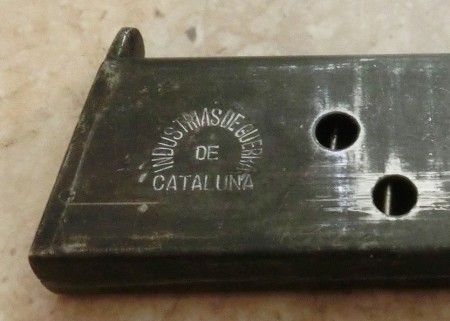
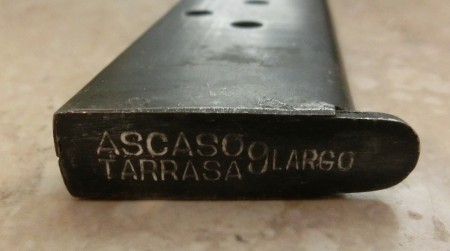 It’s the magazine for an Astra 400 copy made by the Anarchists during the war – the pistol itself will be arriving shortly. Ascaso was a noted Anarchist hero (or terrorist, depending on who you ask) who died early in the war, and a factory in Tarrasa decided to name their pistol production after him. We will get more into who he was and take a look at one of the pistols later, but in the time being there is a very interesting documentary sympathetic to the Anarchist movement available on YouTube. It was filmed at least a couple decades ago, and is largely composed of interviews with folks who participated in the war (it is in Spanish, with English subtitles). I strongly recommend it for anyone interested in seeing that side of the conflict:
It’s the magazine for an Astra 400 copy made by the Anarchists during the war – the pistol itself will be arriving shortly. Ascaso was a noted Anarchist hero (or terrorist, depending on who you ask) who died early in the war, and a factory in Tarrasa decided to name their pistol production after him. We will get more into who he was and take a look at one of the pistols later, but in the time being there is a very interesting documentary sympathetic to the Anarchist movement available on YouTube. It was filmed at least a couple decades ago, and is largely composed of interviews with folks who participated in the war (it is in Spanish, with English subtitles). I strongly recommend it for anyone interested in seeing that side of the conflict:

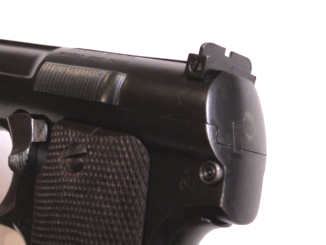
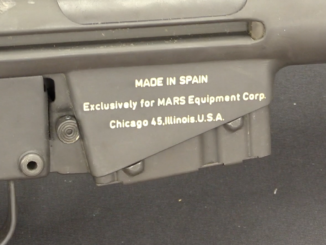
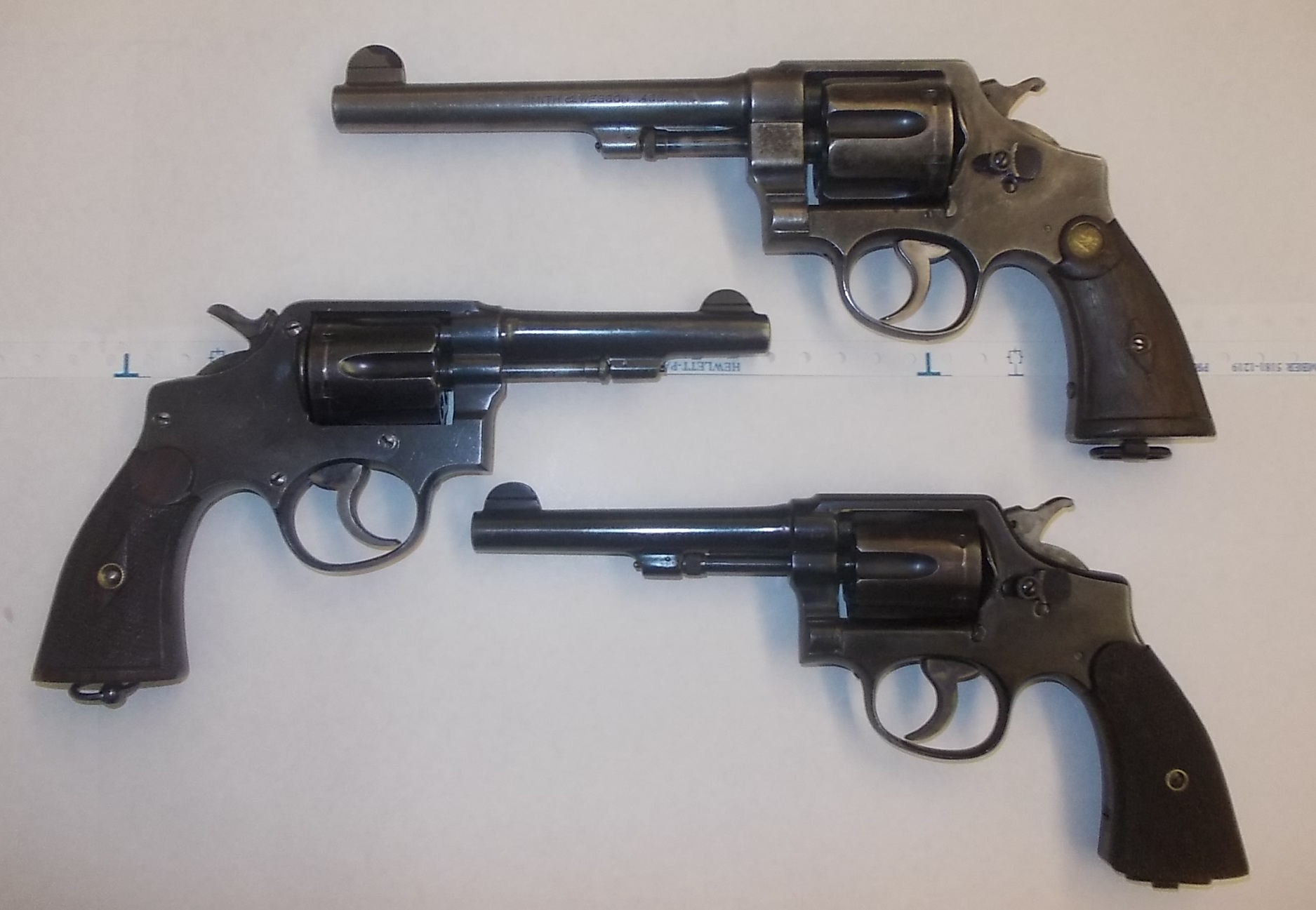
Do you have Len Atari’s new Star firearms book (632 pages), or his Astra book. Great references…and photos. I used to have one of the Star MD 9mm Largo Modelo Militar’s….slotted and with two 32 round magazines. It had been shipped “per factory records…in his book”…to the Mexican Gov’t. in 1931. The rate of fire had to be over 1000 rpm’s. I actually thought it was very controlable. I never found a stock for it….and am still looking for one.
Ian…I have a VZ24 with the Czech acceptance marked out with a unique ‘hatch’ patter, It was shown in a copy of Men at Arms which I purchased exactly because of that photograph…the article described that particular mark as peculiar to the arms produced by the Czechs and ordered by Stalin (or more precisely, his minions) to be sent to the Loyalist (Communist) forces…evidently this shipment never arrived at its destination or that particular rifle was somehow spared the ravages of the Civil War because all the numbers match, including the stock…I bought it from a member of our West Palm/Lake Worth FL collectors group…he in turn got it from an estate which he was liquidating for a widow…usually the BEST way to find a rare C&R nowadays…if you like I’ll find the photo I have scanned from the article (A seriously monumental job considering the state o my files and memory) and send it to you…
CB in FL
Sure, I would definitely be interested in seeing that photo!
Dear Ian, dear All,
the Civil War in Spain was a real blood-bath: beyond the political division there was also a sort of an ethnic war: nazi-fascits in Castilla and other provinces against socialists of Cataluna and Basques, all in all Francisco Franco was aided by Hitler & Mussolini whereas some freedom fighters from N. America volunteered in the raws of Catalunians. The funny thing is that Mussolini and Hitler expected the Generalissimo (most General, very funny to say in English) some pay-back in supportive alliance in WWII and he denied that help, acting like a pacifist after what he did in his mother country, hi !
I have a -sad- story for the Astra 400 pistol: I do not know -mechanically- why but it was a dangerous pistol. My dearest friend passed away 3 years ago at 89 and he was a cadet officer in 1943, he was up north in Italy when the country was broken in two with the king down south and Mussolini with Germans up north. My friend Marino had a fellow cadet who owned one of those spanish pistols and he was handling this gun at dinner, explaining what a marvellous safety the pistol had and to show that out… he killed a comrade ! The guy was sent to the Eastern Front in Russia a few days later and never came back.
So, please my friends I love you all, pls get rid of Astra 400 and the Jap pistol Model Idunnowhat issued to Jap airforce who sometimes shot their thighs during flight, ah !
Ciao, the usual Normann from Venice, Italy
Hello, Normann :
Thank you so much for your concern and care regarding the Astra 400 and the Japanese pistol in question. I certainly appreciate the sad cautionary tale concerning your friend Marino and his fellow soldiers — what a needless tragedy. I am sure other readers on FW will also take this to heart.
Hope all is well with you and your family in Venice. It is always good to hear from you on this website!
That Japanese pistol is likely the Nambu Type 94 Shiki Kenju. The exposed sear was a problem only when the safety catch was disengaged, I believe (just don’t jolt hard, the safety catch might trip to firing position). As long as you don’t carry the Nambu holstered with a round in the chamber, you’re fine.
Hi, Andrew :
Thanks for the additional information. I seem to recall a discussion about the Type 94 pistol on FW, and also on The Firearm Blog, awhile back. The safety question loomed large on both web sites at the time.
And always good hearing form you, Earl! Since we are back on the topic of the Spanish Civil War have you had a chance to dig into “Hermanos!” yet, and if so what do you think?
Killer find on the Living Utopia documentary, Ian. Outstanding explanation of a little-understood point of view. Chinga Franco, yo soy Anarchista.
I’ve handled a few Astras but I have never really had an urge to shoot one… there is something about that design that just strikes me as deeply wrong for a full-power pistol. For Spanish sidearms I much prefer the Star… the Starfire 9mm is a great little farm hip-pocket gun, small enough to be out of the way and heavy enough to enjoy practicing with it a lot. And I’ve always thought it was neat that in every movie you’ve ever seen with a “Colt .45 automatic” (which doesn’t work very well with blanks) from Bogart to Newman it was actually a Star Model B, which blanks up just fine!
But on Spanish 9mms… anyone have any trigger time with the Destroyer carbine? There was a moment in the early 90s when they were available and cheap, and I passed because I had no source of Largo ammo and it looked like a neat little rifle I would want to shoot a lot.
OMG! My first firearm purchase, was in 1961….I ordered an Astra 400 in 9mm Largo from an add in Guns & Ammo magazine. I had to sign a small form, stating I was 18 years old…and mail it in with a USPS m/o for $19.95 and $3 shipping. I was only 16 years old….and had a PO box that I had it sent to. So my parents wouldn’t fing out about it….even though I already had some rifles. The add said it would shoot 9mm Largo, 9mm Bayard, .38 Super, 9mm Parabelum and .380acp. WRONG!! I eventually traded it….never shot it, as I couldn’t find the 9mm Largo ammo.
I’ve had a few destroyers…….one I rechambered to .38 Super….worked fine. Never shot it for accuracy….before I sold it.
David
Howdy Jim, yes on 9mm largo. My wife has a 1963 Franco-era Destroyer carbine in 9mm largo. It is a hoot! Basically a mini-Mauser bolt action with the recoil of a .22, a fairly modest report, and quite accurate at practical ranges in spite of having the typical corrosive ammo damaged bore…Actually not so bad.
We also have a 1937 produced Astra Modelo 1921 (400) 9mm largo pistol. This is a really cartoonish looking pistol, but very nice and accurate too, although the 9mm largo cartridge and near-to-vertical handgrip makes for a strangely sharp recoil sensation.
I’d flat love to have a Francisco Ascaso marked anything! I do have two ex-Ejército Popular de la República Española Mosin-Nagant rifles, but nothing from the union-based and party-based militias.
As far as the death of Ascaso, the day after the Nationalist uprising, the CNT-FAI under Buenaventura Durruti assaulted the cuártel de Atarazanas near the port of Barcelona, and Ascaso was shot in the attack. As Antony Beevor put it: “As in all the fighting, a desperate, selfless bravery was shown by the attackers. … the courage of that attack passed into anarchist folklore, obscuring the fact that dash and bravery are dangerous substitutes for military science.”
Next time I’m through Houston, I’ll try to remember to bring along the Destroyer…yes?
If I may say so, David, that is an intriguing and relatively rare collection that you have. Very nice, and thanks for sharing.
The attached movie speaks quite a bit about background and root causes. It is good (as I often do) to go into following discussion and take a look as to what people think. There are often sharp disagreements about basic terms applied. Quite interesting, part of FW.
Anyway, this topic is getting quite a bit of spin on this blog and I am happy to see that since it is period which drew some interest of mine to the subject in past. So, I want to say thank you.
I find it interesting that Spain, not a poor country before the war, failed to grow after WW-II in spite of his neutrality. Before the revolution/civil war, Spain as a near the middle economy of Europe. The civil war destroyed that and Franco’s dictatorship nationalized everything and outside investors fled the country. Slow growth recipe if there ever was one. It was not until Franco dies and government reforms were installed that the Spanish economy started to grow at a pace near the bottom of European strata. The more they reform, the better they get and now they have a thriving military business.
Spain had passed from being the World superpower in the fifteen and sixteen hundreds, and never properly recovered from the influx of precious metals from its new world conquests.
The inflows of gold and silver, resulted in prices rising within Spain, and hence consumption goods flowing in from other countries, rather than being grown or manufactured in Spain itself.
Once the inflow of specie stopped, Spanish farms orchards and workshops were dilapidated, and the skills to work them had largely been lost.
It’s interesting that the late schoolmen at Salamanca, spent much time pondering the causes of a doubling (or more) of money prices for goods and services, and the increase in imports.
History may never repeat exactly, but it does rhyme.
I hope, Keith, that you help them by retiring there. That would be kind thing to do to both yourself and to them -)))).
If the economy in Spain was so bad under Franco, how were 100,000 of people able to buy personal transportation?
He didn’t nationalize everything. For the international market the privately held motorcycle companies in Spain were the world leaders for off road motorcycles when Franco was alive.
International investors aren’t always a good thing. Very often it creates a house of cards.
I think I can back up you view, with little of knowledge I have regarding Spanish industry status. As far as motorcycle (motorcycles happen to be my major hobby) industry and as you correctly said, it has all but disappeared. Further, as we discussed some time before, the armaments industry nearly ceased to exist in Spain. nothing ‘thrives’ there per se right now, part of unemployment. So indeed, one has to wonder, what was true affect of opening Spanish industry to foreign investments; not always the best thing if left unchecked.
Hi, Denny :
A little off-topic, I know, but you reminded me of a few things. I’ve been a long-time motorcycle enthusiast ( everything from modern high-performance sportbikes to motorcrossers / enduros and vintage classics ). I really liked the Bultaco, Ossa, Montesa, Sanglas, Derbi and Gas Gas bikes from Spain. They were well-made with great performance for their time, and a lot of character besides.
Stunning news, Earl!
Are you still riding? I myself do. I have now for 9th season Honda Hornet 900; little customized, like it a lot. That tells you my preference.
Spain had or still has Yamaha plant there (as had Honda one in Italy), if I am right. Other than that all gone. Derbis were doing very well in races before I left continent. My own preference had been Bultaco Metralla – beautiful little bike; like orro.
From 1960 to Franco’s death the per capita GDP of Spain doubled. In 1960 it was a bit more than Japans. In 1975 it was a bit less than Japans. Interestingly there was much press about Japans miracle but nothing about Franco’s Spain matching it.
It took 30 years after his death for it to double again with outside investors.
All mechanical safeties are subject to fail. Astra’s locks only the trigger and
should be handled and carried awaring of this. I had encountered a small Beretta 914
with all three safeties; manual, grip and magazine, being out of order, but
looking excellent condition at outside.
@ Denny :
The Bultaco Metralla! Now there was a superb little 250cc two-stroke from 1967, with the sort of light weight, nimble handling and acceleration that presaged the advent of Yamaha’s later and immensely successful RD250, RD350 and RD400 by several years.
I am currently between bikes, but have my eye on either a Kawasaki ZX-14R, Suzuki GSX-1300R Hayabusa, Kawasaki ZX-10R or Suzuki GSXR-1000. And maybe a Kawasaki KLR650 or something similar for a second bike for on / off-road use. Among the many bikes ( Japanese, European and American ) I have had the privilege to own ( and I dearly loved them all ) over the years, my all-time favorites were a 1972 Honda CB-750K2, 1972 Ducati 900SS, 1973 Kawasaki H2 Mach IV, 1975 Kawasaki Z-1B, 1975 Suzuki GT750, 1976 Yamaha RD400 and 1980 Suzuki GS1100E. I wish I’d kept those magnificent machines, especially in the light of the recent revival of interest in “standard” or “universal” street bikes.
I should have added a 1973 Norton 850 Commando ( in spite of all the teething problems and high-maintenance requirements ) and 1956 BSA DBD34 Gold Star ( now there was a really sweet machine ).
Wow, interesting… so you are in big liegue Earl! Do you know what I think? No matter how many you have had and how big or small, for real enthusiast like you are, it is never ‘enough’.
Hi, Denny :
I wouldn’t say I’m in the big league. I just try to enjoy what I can afford, and like almost everyone else, I often have to sell or trade-in one item in order to be able to try out another.
Good point about any enthusiast not having enough of a good thing — just like firearms!
A BSA Gold Star? Now I know I’ve been keeping good company. That is the one bike that I’ve never rode or owned that I’d sacrifice a bit to own.
The sentiment is mutual :).
Earl……BSA Goldstar…….great bike. I had one back about 1973. And a few BSA Clubman 350’s….one was a “plunger” frame bike, and the other was rigid frame, that I built into a Hill-climber. Remember those days? I remember selling all of them back about ’90 for $900.
David
Hate be the bearer of bad news but, if the rigid frame was still stock and with a running engine, it would have been worth much more than $900 in 1990. I’d have given at least $2000 for it.
I guess we meet 20 years to late.
I know….but the Clubman was stripped…not street legal, and made for hill climbing. Ran great….tons of low end torque…and it had a big “cheater” sprocket. I would sit at the bottom of the steep hill (and too long to get to the top). I’d just be idling….and at the “go”……I’d slowly give it R’s…..and it’d chug up the hill. It would turn the knobiest of knobies….and I’d go straight up the hill (won a few races). Two strokes were the favorite….but they needed speed to get up the hill….fish-tailing the whole way.
LOL…too many good memories. Oh yes……I forgot….when I got to end of my run….I’d just lay the bike over and let it slide down the hill. Too heavy to try and hold it….unless you wanted to start tumbling with a 300lb monster.
David
My other Clubman was on the way to being “street legal” restored….but never completed it. The Goldstar was a project-bike. Someone had been racing it, and punched the engine out to 600….and blew the engine. I never got it running….oh, and it had crashed. It would be worth restoring today. I should have just kept the tank….it was a beaut’.
Wow, I do remember those days very, very well indeed! BSA 350 Clubmans were great — so simple and versatile, and capable of adaptation to so many roles while staying tractable. Wish you’d kept them, but in retrospect I guess we’re all guilty of 20-20 hindsight.
To All :
Sorry for getting carried away about motorcycles. I guess it’s the same fascination I have for anything mechanical ( and the form, function and history that follows ), including firearms, that drives my interest.
Thanks very much for your forebearance and, as Denny has gently reminded us more than once, many thanks are due to Ian M. for his open-minded generosity in allowing for some off-topic discussions.
Thanks for the delightful insight on your motorcycle passion, Earl! I am also a motorcycle enthusiast since my teenage years and I fully understand your point, believe me! I feel the same sort of fascination for anything mechanical (with an interesting design and industrial history to go with if possible)… Just don’t get me started on old, pre-1980s photo cameras and lenses, especially rangefinders…
P.S.: I am also between bikes right now, but I am seriously considering the latest version of the Kawasaki Z1000SX, with (if just I were a tad richer than I am!) perhaps one of those nice, recent neo-retros for a second bike .
Thanks for sharing, Ruy! As for vintage cameras, I’m afraid you’ve awakened more good memories — especially for the old Leica and Rolleiflex cameras ( courtesy of my late father ).
Somehow, I sense that most readers of FW share many similar passions for the mechanically old and intriguing ( and not only firearms of this genre ), otherwise we all wouldn’t be here :).
@Denny: Its the other way round: Yamaha is producing some Single-Cylinder (XT660) bikes in Italy right now and had a close relationship with Belgarda who made some very interesting italian-japanese cross-breed yamahas like the TT600 and the SZR660.
Honda is cooperating with Montesa. They assembled some motorbikes like he SLR650 in spain. Labour is less expensive than in japan, but also the quality is not quite the same…
For everyone who is interested in spanish mc history, you have to check
http://www.museovehiculosguadalest.com/
If you are ever in the Costa Blanca area between Valencia and Alicante I strongly recommand you to go there!
Some of my own pictures:
http://www.imgbox.de/show/gallery/motorrad/y4BzTHzIKs_Museo_Vehiculo_2012/
Very interesting Felix. Thanks for your contribution to my passion! (Heck, cannot live just on one, right?!). The motorcycle market and production are completely internationalized, just as anything else. As far as I know, Honda is well entrenched in Italy as well – for example BFR1000 is made there, very successful bike on UK market. Of course, the Yamaha’s single are absolute must for real single’s aficionado. I am very much for mutual crosspollination, it helps creativity and benefits users. Take care!
Yamaha SR500 is my current ‘big’ bike that I ride. Although I’ve owned a couple of twins for the street I prefer single. Most of my flattrack racing was done on 4-stroke singles.
But what I collect is Yamaha 250cc 2-stroke twin flattrackers. Them being raced was a bit before my time, but I’ve never talked to any of the older guys who raced that didn’t love them and say using was like cheating.
I’ve gotten out of collection and/or riding Spanish bikes. Sold my OSSA Stiletto TT and other OSSAs years ago. Same with the Bultaco Astros. I might still have enough Astro parts around to put an early framed version together if I wanted to.
When I posted about the Spanish motorcycle industry I thought people here wouldn’t know that Spain had an international known motorcycle industry.
FWIW. Honda moved into Italy when a law was passed that restricted the import of smaller bikes. I think 350cc(?).
The Yamaha SR500 is a terrific sporting single that embodies all the panache of the traditional lightweight 500cc singles while adding many wonderful modern upgrades to chassis, brakes, suspension and ergonomics — a completely under-rated bike with outstanding handling and 110% pure fun factor on twisty back roads.
I also wanted to add that the SR500 is in many ways the BSA Gold Star of the modern era — a most fitting tribute to its character and qualities.
Indeed Earl, I do agree. The SR500 is a very successful mix of classic styling with current motorcycling technology.
A very interesting bike I am about to test drive is the recent Kawasaki W800, a worthy competitor to the popular ‘modern classic’ Triumphs. It also lends itself to custom builds, along café racer lines; there’s one outfit in Germany, LSL Motorradtechnik of Krefeld, performing excellent work of that kind. They used to work preferably on Triumphs but now the W800 is becoming a solid favorite for such jobs; a good example can be viewed here: http://www.bikeexif.com/lsl-kawasaki-w800
Thanks for the link to LSL Motorradtechnik’s work — it was great! I really wish more outfits here in the U.S. would do this kind of work, but they are mostly focused on high-end, high-performance bikes. While I am an aficionado of those motorcycles, I am also cognizant of the fact that there are many other machines that are no less distinctive and able to provide equal measures of fun in similar ( or different ) ways.
As far as I’m concerned, each and every one has a distinctive character and should be enjoyed for what it is.
Nice links, Felix — thanks! The sport of motorcycling is much more diversified in Europe than here in North America, or anywhere else in the world for that matter, with all sorts of really interesting makes and models ( like the cross-overs you mentioned ) that are unobtainable in the U.S. except by special order with the right permitting and government approvals. I hope it stays that way where you are, and doesn’t become homogenized as it has elsewhere.
Back in the 1970s BMW made a neat 2 cylinder (flat opposed) bike that was super quiet and quite fast. A neighbor on base (Nellis AFB, NV) had one.
There were several iterations of the famous BMW “R”-series horizontally-opposed twins available in the 1970’s, including the R50/5, R60/6, R65, R75/5, R75/6, R80/7, R90/6, R/90S, R100/7, R100S, R100RS and R100RT, among others. Of this particular generation of BMW’s, the R/90S was generally reckoned to be the best of the lot, light and nimble with good suspension, handling and power that made it an excellent sportbike.
BMW’s horizontally-opposed, transversely-mounted, twin cylinder Boxer engine goes back in its original concept to the R32 of 1923, and this configuration is still with us today in a new-generation “R” series of motorcycles.